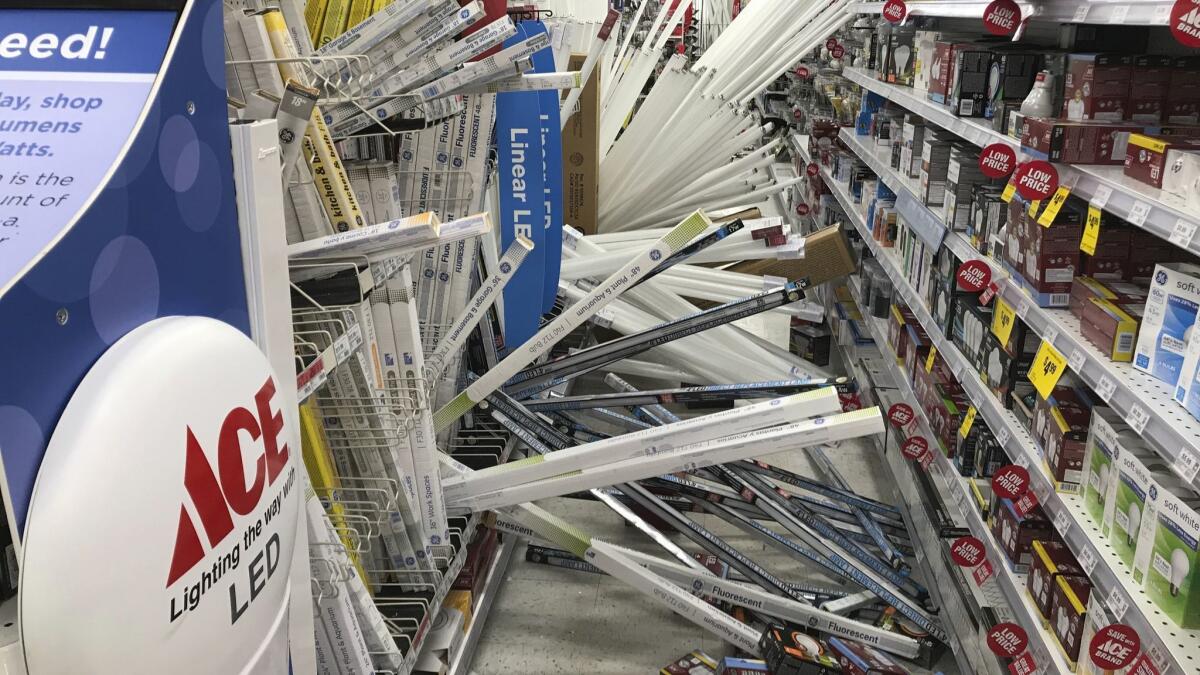Anchorage earthquake was a big one, but it could have been much worse. Why L.A. should take warning

Buildings cracked. Roads collapsed. People were injured by falling debris.
But for all the ferocity of the magnitude 7.0 earthquake that struck the Anchorage area on Friday, the temblor did not cause the catastrophic damage or loss of life that have occurred from even smaller quakes both around the world and in California.
Friday’s Alaska quake actually was larger in magnitude than the 1989 Loma Prieta quake and the 1994 Northridge quake, each of which killed more than 50 people and caused billions of dollars in damage.
What was the difference?
Experts emphasized they are still studying the Anchorage temblor but said several factors made it less destructive than other major quakes.
For one thing, the quake was not centered directly under Anchorage. The epicenter was about 8½ miles away, said Jonathan Tytell, a geophysicist with the U.S. Geological Survey. That’s still fairly close, but doesn’t have the same effect as if it were directly under the city.
The quake was also fairly deep — 25 miles underneath the surface — which also resulted in less shaking at the surface, said Joann Stock, a geology and geophysics professor at Caltech. The magnitude 6.7 Northridge quake hit directly underneath the suburban San Fernando Valley and was much shallower — just 11 miles underground — than the Anchorage quake, so more of the shaking energy made it to the surface, causing more damage.
“Earthquakes are just complex,” said Heidi Tremayne, director of the Earthquake Engineering Research Institute. “Each has its own thumbprint.”
How about the infrastructure?
Much of the structural damage seen in Anchorage was the result of liquefaction, which is when sediments and water are shaken together and act like quicksand.
Anchorage is a newer city, with fewer old buildings that are likely to collapse, Tremayne said. Building codes for newer construction are designed to allow buildings to easily withstand the shake intensity ranges seen in the Anchorage earthquake, she said.
The great 1964 Alaska quake — a magnitude 9.2 monster that battered the whole West Coast with shaking and tsunamis — significantly damaged many buildings, so there are few of Anchorage’s oldest structures left, Tremayne said. That’s not the case in many other cities.
In California, for example, a Los Angeles Times analysis published this year found that there are hundreds of old brick buildings in the Inland Empire that have been marked as dangerous but haven’t been retrofitted despite decades of warning.
Across California, there are other vulnerable building types, such as apartments with parking on the ground floor, older houses with a handful of steps off the ground, and vulnerable concrete and steel buildings.
RELATED: Here’s what earthquake magnitudes mean—and why an 8 can be so much scarier than a 6 »
Unlike Anchorage, many California cities have not been shaken by what scientists consider a major earthquake in the modern era. San Francisco’s last extremely large earthquake was in 1906, with an estimated magnitude of 7.9. Southern California’s last great one was in 1857, also an estimated magnitude 7.9, which moved the San Andreas fault an astonishing 185 miles between Monterey County and the San Gabriel Mountains near Los Angeles.
The 1964 Alaska temblor, the second-largest earthquake in the modern record, produced 1,995 times more energy than Friday’s quake. It lasted 4½ minutes and, along with its tsunamis, killed more than 120 people. It was felt all the way to Seattle, where witnesses said they felt the landmark Space Needle swaying.
A later U.S. Geological Survey study found that an area of 185,000 square miles was disrupted. There were areas that dropped as much as eight feet and others rose 38 feet. Barnacles attached to rocks that used to be two feet underwater were suddenly in the open air. A section of downtown Anchorage sank. Underwater landslides in Alaska’s fjords caused tsunamis within minutes of the shaking. Three huge waves washed into Whittier from Prince William Sound within three minutes. Chenega, to the south, lost 23 people, one-third of its population. To the north In Valdez, 30 died as the harbor and docks collapsed. Eleven people were killed by a tsunami that hit Crescent City, Calif.
What is the takeaway for California?
California has a long history of large earthquakes, and experts said the Anchorage destruction should be another warning to prepare.
A similar-size earthquake around downtown L.A. would be much more destructive because the buildings are older and the area much more densely populated.
“In the Los Angeles area there’s a much more extensive array of infrastructure throughout the city,” said Tytell. “Up in Alaska, things are a little bit more rural, a little bit more spread out. But make no mistake, there is a city there.”
Aside from the mighty San Andreas fault, Southern California is criss-crossed with smaller faults that pose major dangers, including the Newport-Inglewood fault, which produced the 1933 Long Beach quake, and the Hollywood fault, which runs through the heart of Los Angeles.
Another big concern is the Puente Hills thrust fault, which runs from near Whittier through downtown L.A., USC and Dodger Stadium, before veering west toward Beverly Hills.
alejandra.reyesvelarde@latimes.com
Twitter: @r_valejandra
More to Read
Sign up for Essential California
The most important California stories and recommendations in your inbox every morning.
You may occasionally receive promotional content from the Los Angeles Times.











